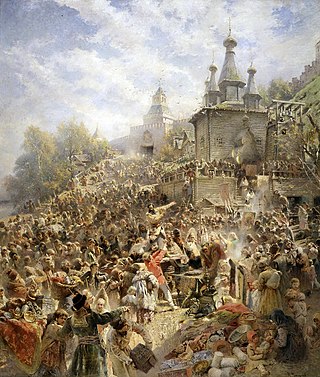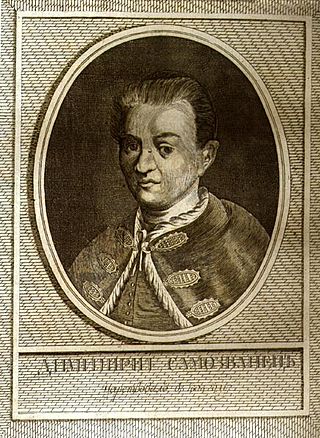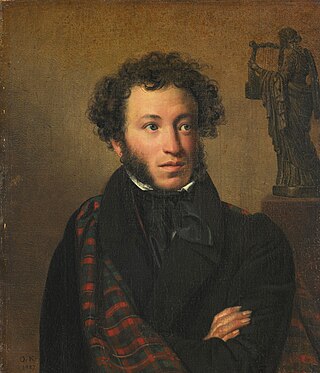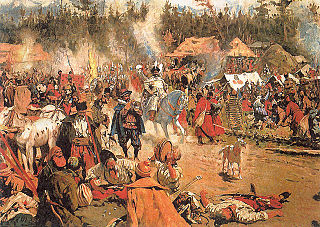
The Battle of Klushino, or the Battle of Kłuszyn, was fought on 4 July 1610, between forces of the Polish–Lithuanian Commonwealth and the Tsardom of Russia during the Polish–Muscovite War, part of Russia's Time of Troubles. The battle occurred near the village of Klushino near Smolensk. In the battle the outnumbered Polish-Lithuanian force secured a decisive victory over Russia, due to the tactical competence of hetman Stanisław Żółkiewski and the military prowess of Polish hussars, the elite of the army of the Crown of the Kingdom of Poland. The battle is remembered as one of the greatest triumphs of the Polish-Lithuanian cavalry and an example of excellence and supremacy of the Polish-Lithuanian military at the time.

The Time of Troubles, also known as Smuta, was a period of political crisis in Russia which began in 1598 with the death of Feodor I, the last of the House of Rurik, and ended in 1613 with the accession of Michael I of the House of Romanov.

False Dmitry I reigned as the Tsar of all Russia from 10 June 1605 until his death on 17 May 1606 under the name of Dmitriy Ivanovich. According to historian Chester S. L. Dunning, Dmitry was "the only Tsar ever raised to the throne by means of a military campaign and popular uprisings".

Vasili IV Ivanovich Shuisky was Tsar of all Russia from 1606 to 1610, after the murder of False Dmitri I. His rule coincided with the Time of Troubles. He was the only member of House of Shuisky to become tsar and the last member of the Rurikid dynasty to rule as tsar.

The Polish–Muscovite War of 1605–1618, also known as the Polish–Russian War, Polish Intervention in Russia or the Dimitriads, was a conflict fought between the Polish–Lithuanian Commonwealth and the Tsardom of Russia from 1605 to 1618.
Ivan Isayevich Bolotnikov headed a popular uprising in Russia in 1606–1607 known as the Bolotnikov Rebellion. The uprising formed part of the Time of Troubles in Russia.

Boris Godunov is a closet play by Alexander Pushkin. It was written in 1825, published in 1831, but not approved for performance by the censor until 1866. Its subject is the Russian ruler Boris Godunov, who reigned as Tsar from 1598 to 1605. It consists of 25 scenes and is written predominantly in blank verse.

The Battle of Moscow was a series of two battles, which took place in Moscow, on September 1 and 3, 1612, during the Polish–Muscovite War (1605–18), and Time of Troubles. Forces of the Polish–Lithuanian Commonwealth were commanded by Field Hetman of Lithuania, Jan Karol Chodkiewicz, while the Russians were led by Dmitry Pozharsky. Battles ended in decisive Russian victories.

The Battle of Novgorod-Seversky was the first major battle of False Dmitry I against Boris Godunov.

The siege of Kromy was the last major clash of government troops of Boris Godunov with the rebel army of False Dmitry I.

In the Battle of Bolkhov on May 10–11, 1608, the troops of False Dmitry II managed to defeat the army of Tsar Vasily Shuisky.

The Battle of Kozelsk was the first victory of False Dmitry II against the government of Tsar Vasili IV Shiuski.

The siege of Moscow was the last major military action of Wladyslaw IV's campaign of 1617–1618 and the entire Polish-Muscovite War (1605–1618). During the short siege, which lasted several weeks in the autumn of 1618, an assault of the city was unsuccessful. Having failed, the Polish-Lithuanian government went to the conclusion of the Truce of Deulino.

The Battle of Mozhaysk was a series of battles at the final stage of the Polish-Muscovite War (1605–1618) on the western approaches to Moscow. The battle is part of the Moscow campaign of Wladyslaw IV. During months of fighting, the Russian armies managed to maintain their combat capability and prevent the rapid seizure of Moscow. However, the threat of encirclement forced the Russian troops to retreat, opening the way for the enemy to the capital.

The Battle of Gdov in the Russo-Swedish War took place on September 16, 1657 in Gdov. The battle was a clear victory for Prince Ivan Khovansky of the Tsardom of Russia over Swedish Governor-General Count Magnus De la Gardie allowing the Russians to regroup after a brief resurgence of Swedish resistance.
Prince Vasily Vasilievich Golitsyn was a Russian commander, nobleman and governor. Golitsyn was a prominent figure during the Time of Troubles between 1587 and 1613.

The Battle of Torzhok was a battle on June 17, 1609 between the advanced units of the Russian-Swedish army led by Prince Mikhail Skopin-Shuisky and Jacob De la Gardie and the army of Polish–Lithuanian invaders who fought for False Dmitry II, led by Alexander Zborovsky. It ended with the defeat of the interventionist troops and its retreat.

The Zemsky Sobor of 1613 was a meeting of representatives of the Estates of the realm of the Tsardom of Russia, held for the election of Tsar after the expulsion of the Polish-Lithuanian Occupiers at the end of the Time of Troubles. It was opened on 16 January 1613 in the Assumption Cathedral of the Moscow Kremlin. On 3 March 1613, the Sobor elected Mikhail Romanov as Tsar, establishing the House of Romanov as the new Russian monarchs. The coronation of Michael I is widely considered to be the end of the time of troubles.

Wigund-Jeronym Trubecki or Yuri Nikitich Trubetsky as he was called earlier in Muscovy was the Prince of Trubetsk from 1611 to 1634, preceded by Symeon Iwanowicz Perski Trubecki, succeeded by Piotr Trubecki, and Aleksander Trubecki. Yuri Nikitich Trubetsky was also a boyar and equestrian of False Dmitry II. After emigrating to Poland, and restoring The Principality of Trubetsk, he converted to Catholicism, and took the name Wigund-Jeronym Trubecki.
Godunov is a Russian historical drama television series created by Ilya Tikin and Nikolay Borisov, directed by Alexei Andrianov and Timur Alpatov. The first season premiered from November 5 to November 8, 2018 on the "Russia-1" national TV channel. The second season premiered from March 25 to March 29, 2019.














